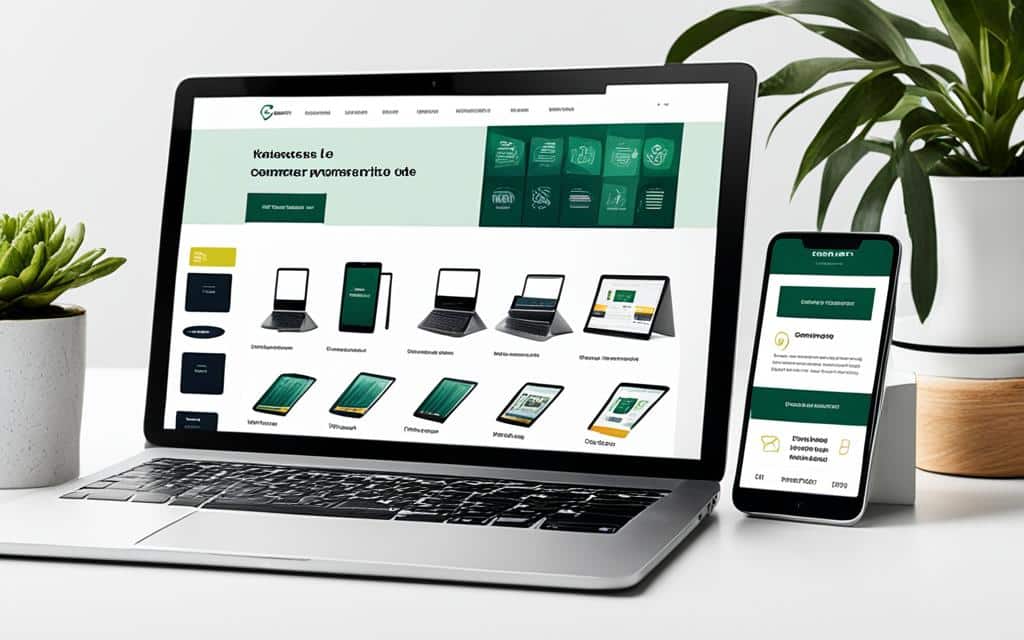Table of Contents
Mobile responsive web design is crucial for e-commerce as mobile devices become the preferred platform for online shopping. Mobile e-commerce sales are projected to reach $314 billion in 2021, accounting for 54% of total e-commerce sales. To stay competitive, it is imperative to have a mobile responsive web design for your retail website.
Consumers expect intuitive navigation and a seamless shopping experience, whether they are using a desktop computer or a mobile device. Responsive web design adjusts the layout based on the device, improving the user experience and increasing repeat visitors and conversions.
Furthermore, responsive design improves the search engine optimization (SEO) of your website and enhances page speed, which are important factors in search engine rankings.
Whether your customers are shopping on a smartphone or desktop, a mobile responsive web design is crucial for a seamless and intuitive shopping experience. Responsive design ensures your website adapts to fit any screen size, providing a consistent and user-friendly interface. With mobile e-commerce sales on the rise, investing in responsive design is essential for maximizing your online sales potential.
In this article, we will explore the basics of responsive web design, the advantages and limitations of mobile e-commerce sites, and how you can optimize your mobile site for an enhanced shopping experience. By implementing responsive design principles and improving site navigation and usability, you can create a mobile e-commerce site that drives sales and keeps customers coming back for more.
The Basics of Responsive Web Design
Responsive web design is a crucial aspect of creating a user-friendly and visually appealing website that can adapt to fit any size screen. Whether visitors access your website from a desktop computer, tablet, or mobile device, responsive design ensures that they have an optimal viewing experience. By making use of adaptive elements, such as buttons, phone numbers, menu navigation, and form fields, you can avoid errors and provide a seamless browsing experience.
A responsive website automatically adjusts its layout based on the device, enabling visitors to easily navigate and interact with the content. This significantly improves the time spent on your site, increases repeat visitors, and boosts conversions. Additionally, responsive web design plays a vital role in improving search engine optimization (SEO) and page speed, both of which directly impact search engine rankings.
Whether your audience uses a mobile device or desktop computer, responsive design ensures a consistent and intuitive user experience. By prioritizing mobile and desktop compatibility, you can effectively engage your visitors and drive the desired actions, such as making a purchase or filling out a form.
To illustrate the concept of responsive web design, consider the following example:
An e-commerce website sells various products, ranging from clothing to electronics. With responsive design, the website seamlessly adapts to different devices, providing an equally intuitive user experience on both mobile and desktop platforms. The layout adjusts based on screen size, ensuring that customers can easily browse product categories, view item details, and complete purchases, regardless of the device they are using.
Furthermore, responsive design incorporates elements such as easy-to-read text, clear images, and accessible navigation menus, contributing to a positive user experience. Visitors can effortlessly find what they are looking for, promoting customer satisfaction and increasing the likelihood of repeat visits and conversions.
“Responsive web design ensures a seamless browsing experience for users, regardless of the device they use.”
Advantages of Responsive Web Design:
- Provides a consistent and intuitive user experience
- Ensures mobile and desktop compatibility
- Improves SEO and search engine rankings
- Enhances page speed and performance
- Increases visitor engagement and conversions
Disadvantages of Responsive Web Design:
- May require additional development time and resources
- Complex designs could impact loading times
- Requires careful attention to detail for optimal responsiveness
Overall, responsive web design is essential for creating a website that fits seamlessly into any size screen, offering an adaptive and intuitive user experience. By prioritizing mobile and desktop compatibility, businesses can cater to a wider audience and provide a consistent brand experience across various devices.
The Advantages and Limitations of Mobile Ecommerce Sites
Mobile optimization for ecommerce is crucial in today’s digital landscape. With the increasing use of mobile devices for online shopping, it is essential to provide a user experience friendly to mobile users. Responsive web design allows your ecommerce site to adapt seamlessly across different devices, ensuring legible and concise content as well as fast page loading times. This mobile optimization approach is not only cost-effective but also SEO friendly, as search engines prioritize websites that offer a good user experience.
One of the main advantages of mobile optimization is consistency. By ensuring that your site is optimized for mobile, you create a consistent brand experience for your customers, regardless of the device they use. This consistency builds trust and loyalty, leading to increased conversions and repeat business.
However, there are limitations to mobile ecommerce sites that need to be considered. One potential limitation is the possibility of slower downloads if the mobile design is poorly executed. Slow page loading times can negatively impact user experience and lead to higher bounce rates. It is crucial to prioritize efficient coding and optimize images and other website elements to minimize download times.
Additionally, converting an existing desktop site to a mobile-optimized version can be a time-consuming development process. This is especially true if the original site was not designed with mobile responsiveness in mind. It may require restructuring the layout, redesigning certain elements, and thoroughly testing the site on different devices and screen sizes. The development and testing process can take time and resources.
Despite these limitations, the advantages of mobile optimization for ecommerce outweigh the challenges. By providing a user-friendly experience on mobile devices, you can attract and retain a larger customer base. The cost-effective nature of responsive web design eliminates the need for separate interfaces for different devices, saving time and money. Furthermore, the SEO friendliness of mobile optimization improves your website’s visibility in search engine rankings, driving organic traffic and potential customers to your site.
In conclusion, mobile optimization is vital for the success of an ecommerce site. It creates a user experience friendly to mobile users, enhances SEO, and ensures consistency across devices. While there are limitations to consider, such as slower downloads and time-consuming development, the benefits of mobile optimization make it an essential strategy for achieving ecommerce success.
The Advantages and Limitations of Mobile Ecommerce Sites Summary Table
| Advantages | Limitations |
|---|---|
| Enhanced user experience on mobile devices | Potential for slower downloads if poorly executed |
| Cost-effective with responsive web design | Time-consuming development process |
| SEO friendly | |
| Consistency across devices |
Mobile Optimization for an Enhanced Ecommerce Experience
When it comes to creating a mobile ecommerce site, incorporating key design elements is essential to enhance the user experience. One such element is minimalistic design, which focuses on simplicity, clarity, and function. By removing unnecessary elements and emphasizing the essentials, this design approach creates a clean and user-friendly experience.
Minimalistic design also has the added benefit of improving page loading times, allowing users to quickly access the information they need. With faster page loading, users are more likely to stay on your site and complete their desired actions, resulting in higher conversions.
Another important design element to consider is the grid layout. This layout provides a clear framework for users to scan and understand the search results more easily. For mobile ecommerce sites with smaller screens, a grid layout ensures that the information is presented in a concise and organized manner, preventing users from feeling overwhelmed or frustrated.
Negative space, also known as white space, is another design principle that contributes to an enhanced browsing experience. By strategically incorporating negative space, you can create a sense of balance in the design. This allows key elements like product images and shopping cart buttons to stand out, improving overall usability. Additionally, negative space helps improve page loading times, contributing to a seamless and enjoyable user experience.
By implementing these design principles, you can optimize your ecommerce store for a better mobile experience. These elements work together to create a visually appealing and user-friendly interface that facilitates efficient browsing and faster page loading. Ultimately, this leads to increased user satisfaction and improved conversion rates on your mobile ecommerce site.
The usability and navigation of a mobile shopping site play a crucial role in providing a seamless browsing experience for users. To optimize the user experience and drive more sales on your mobile ecommerce site, consider implementing the following strategies:
- Search bar optimization: Make sure the search bar is easily accessible and prominent on every page. This allows users to quickly find products they are looking for.
- Main drop-down menu: Ensure the main drop-down menu is well-organized and easily navigable. Provide concise listings of the website’s main sections to help users find what they’re looking for.
- Product categories: Structure product categories logically and prominently display them on your mobile site. This makes it easier for users to browse and find desired products efficiently.
- Intuitive navigation: Create an intuitive and user-friendly navigation experience by utilizing clear and concise labels for menu items and buttons. Users should be able to navigate effortlessly throughout your site.
- Quick access to key features: Highlight key features such as the shopping cart, wishlist, and account login by placing them in easily accessible locations. This ensures users can quickly access important features without any hassle.
By implementing these improvements in navigation and usability, you can provide an enjoyable browsing experience for your mobile ecommerce site users, leading to increased sales and customer satisfaction.
Conclusion
Mobile eCommerce has revolutionized the way people shop online, with a significant number of users opting for mobile devices. To ensure success in the digital marketplace, it is crucial to create a user-friendly and optimized mobile eCommerce site. Responsive web design plays a key role in providing an enhanced user experience and improving SEO. By adapting to different screen sizes and devices, responsive design ensures that your website always looks and functions its best, no matter how users access it.
Incorporating design elements such as minimalistic design, grid layout, and negative space further enhances the usability and navigation of your mobile eCommerce site. A clean and clutter-free design contributes to faster page loading times, allowing users to find the information they need quickly and easily. By optimizing key features like the search bar, main drop-down menu, and product categories, you can provide a seamless browsing experience for your users.
Optimized navigation is essential to encourage users to explore your site and make purchases. By organizing your site’s content and providing intuitive navigation, you can help users find what they’re looking for with ease. By focusing on mobile optimization, you can deliver a user-friendly experience that drives sales and improves customer satisfaction.
As mobile devices continue to dominate the online shopping landscape, optimizing your mobile eCommerce site is crucial for the continued growth and success of your business. By embracing responsive design, incorporating effective design elements, and optimizing navigation, you can create a mobile eCommerce site that provides an enhanced user experience, improves SEO, and drives sales. Stay ahead of the competition and cater to the needs of your mobile-savvy customers by prioritizing mobile optimization for your eCommerce business.
FAQ
Why is mobile responsive web design crucial for e-commerce?
Mobile responsive web design is crucial for e-commerce as mobile devices become the preferred platform for online shopping. With mobile e-commerce sales projected to reach 4 billion in 2021, accounting for 54% of total e-commerce sales, it is imperative to have a mobile responsive web design for your retail website. Consumers expect intuitive navigation and a seamless shopping experience, whether they are using a desktop computer or a mobile device.
What is responsive web design?
Responsive web design refers to designing websites that can adapt to fit into any size screen, whether it is displayed on a desktop, tablet, or mobile device. Responsive design ensures that your website provides an optimal experience for visitors, regardless of the device they use. Elements like buttons, phone numbers, menu navigation, and form fields need to be made responsive to avoid errors and provide a user-friendly experience.
What are the advantages of mobile optimization for e-commerce?
Mobile optimization is crucial for e-commerce sites, as it offers a user-friendly experience on mobile devices and contributes to the success of an online store. Responsive web design ensures that the site adapts seamlessly to any device, providing legible and concise content and fast page loading. It is cost-effective, as it reduces the need for different interfaces for different devices. Responsive design is also SEO friendly, as search engines prefer websites that provide a good user experience.
Are there any limitations to mobile e-commerce sites?
Yes, there are limitations to mobile e-commerce sites. For example, there may be slower downloads if the design is poorly executed. Converting an existing desktop site to mobile can also be time-consuming. However, despite these limitations, the advantages of mobile optimization outweigh the challenges, making it essential for the success of an e-commerce site.
What design elements enhance the mobile e-commerce experience?
To create an appealing mobile e-commerce site, it is important to focus on key design elements that enhance the user experience. Minimalistic design, characterized by simplicity, clarity, and function, creates a clean and user-friendly experience. A grid layout provides a clear framework for users to quickly scan and understand the search results. Negative space, or white space, helps create balance in the design, highlighting key elements like product images and shopping cart buttons.
The usability and navigation of a mobile shopping site play a crucial role in providing a seamless browsing experience for users. Optimizing the search bar by making it easily accessible and prominent allows users to quickly find products they are looking for. The main drop-down menu should be well-organized and easily navigable, with concise listings of the website’s main sections. Structuring product categories logically and incorporating filters and sorting options helps users find desired products efficiently.
Why is mobile optimization essential for e-commerce success?
Mobile e-commerce has become a game-changer in online shopping, with a significant percentage of users opting for mobile devices. Creating a user-friendly and optimized mobile e-commerce site is crucial for success in the digital marketplace. Responsive web design, with its ability to adapt to different screen sizes and devices, provides an enhanced user experience and improves SEO. By optimizing the search bar, main drop-down menu, and product categories, you can ensure a seamless browsing experience for users and drive more sales on your mobile e-commerce site.













